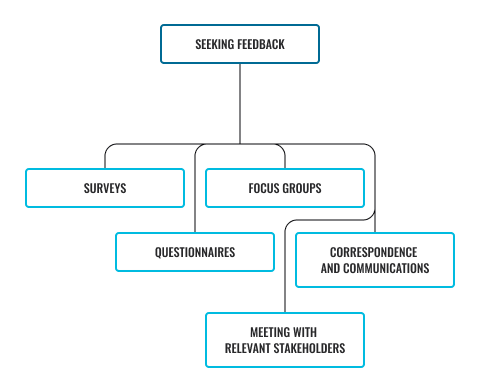Maintaining a critical thinking mindset is an essential factor for living a successful life and a skill that employers look for in prospective employees, regardless of their position in the organisation. To recap, if you are a critical thinker, you will:
- solve problems
- create logical conclusions and solutions
- gather, assess, and interpret relevant information
- ask questions that matter
- develop solutions for these questions
- be creative, curious and independent.
In this topic we will review decision-making practices that typically occur at work. We will also briefly discuss ways of seeking feedback on the use of critical thinking from relevant stakeholders and identify areas for self-improvement. Scenarios based on the fictional company, Ace Services, will be provided to illustrate the learning.

Decision-making practices refer to activities or strategies that can help you improve your decision-making skills. Throughout her time at Ace Services, Michelle has learned some strategies that have helped her develop her own critical thinking mindset. Some of the practices she has found most helpful are shown in the following table.
| Decision-making practice | Description |
|---|---|
|
Prioritising decisions |
Decision-making can get confusing when you are presented with many alternatives. Despite this, you must always prioritise your decisions based on their importance and urgency. Always highlight tasks that need to be accomplished immediately. Tasks that are not important and not urgent can be done later. |
| Limiting the number of people involved in the decision-making process | You should limit the number of decision-makers, especially when you are working in teams or committees. This is important because it helps you assign tasks easier and will also help you work more efficiently. |
| Using decision-making matrices and frameworks | Decision-making matrices and frameworks like the Eisenhower Matrix (or model) and the SPADE Framework can help you make more careful, well-thought decisions. They help you prioritise your tasks and solve difficult problems. |
| Avoiding biases | When making decisions, always ensure that your mind is free from biased thoughts. Having biased thoughts can cloud your judgment and prevent you from making the best decision there is. |
You can conduct a review of decision-making practices in your workplace, work area or work practice by:
- Identifying the decision-making practice: The first step for reviewing a decision-making practice is to identify the decision-making practices that are being followed in your organisation. For example, at Ace Services, employees refer to the Decision Making Policy and Procedure. Some organisations will require you to work in teams and committees. When you are working in a team or committee, it is important not to decide without the input of other team members or committee members.
- Gathering information on the decision-making practice: After identifying your organisation’s decision-making practices, you must then gather information on these practices. You can do this by asking others for their thoughts and opinions about your workplace’s decision-making practices, checking your organisation’s policies and procedures, and observing what other people in the organisation do.
- Identifying the pros, cons, and risks that come with the practice: Identifying the pros, cons, and risks of your decision-making practices will help you determine which practices to follow and which to avoid. It will also help you anticipate possible outcomes that may come because of your decision-making practice.

Feedback is defined as:
advice, criticism, or information about how good or useful something or someone's work is. 1
Feedback provides you with information on how you are progressing in reaching your goals. Feedback is needed because it helps you avoid mistakes, motivates performance, keeps you on track, advances your career and helps you assess your workplace performance.
Because critical thinking is needed in the workplace, seeking feedback will help you evaluate how well you are applying critical thinking at work. It will help you to build confidence, learn from your mistakes, and develop a critical-thinking mindset. Seeking feedback from relevant stakeholders is vital to promoting professional and personal growth. It helps you obtain information on how to optimise your work practices and avoid repetitive mistakes.
Seeking feedback
It is normal to wonder whether you successfully completed a task or if your performance needs work. Seeking feedback can confirm your thoughts and motivate you to do better. There are many approaches you might consider for seeking feedback.

Seeking feedback from others is not always easy. Sometimes, you may feel like your questions sound silly or that whoever you choose to approach might not want to give you feedback. Despite this, it is important to note that asking for feedback is normal, especially in a workplace setting. Remember that asking for feedback saves you time and effort from figuring things out on your own!
Tips for seeking feedback
Select the following to learn some useful tips for seeking feedback.
Remember to explain why you are seeking their feedback and how their honest feedback can help you in the long run. Encourage them to avoid holding back and assure them that you will need honest feedback to improve your performance and to grow in the workplace. You can state your intentions by:
- Scheduling a meeting with your stakeholders
- Asking open-ended questions
- Asking rating-based or yes/no questions
- Asking clarifying questions
- Asking for honesty
Listening is one of the most important steps in seeking feedback. Ensure to listen to what the stakeholders are saying regardless if it is positive or negative feedback. You must be willing to accept whatever their opinions are.
Writing their comments down will not only help you remember what they said but will also help you internalise what they are saying. It will help you process your emotions and will also give you something to look back on. You can list down your successes and the areas that you can improve on.
When seeking feedback, it is important to focus more on what you can improve on than what you did wrong. Remember to focus on the future and avoid dwelling on your mistakes. Ask what you can improve on moving forward and always be willing to listen.
Because feedback can be either positive or negative, you should separate what is being said from how it is being said. People may sometimes fail to notice how they are conveying their message. Always take the time to understand what they are saying and do not take their feedback too personally. Remember that what they are saying can help you in the long run.

Self-development is defined as:
the process by which a person's character or abilities are gradually developed. 2
Self-development helps you:
- assess your performance
- communicate your concerns
- open up to criticism.
It is also a continuous process that requires constant input and improvement. Self-development and self-evaluation go hand in hand. The following table identifies and briefly describes aspects to consider when identifying areas for self-development.
| Aspect | Description |
|---|---|
| Strengths | Strengths refer to skills and knowledge that one develops and perfects over time with disciplined effort. They are tasks and activities one does with proficiency, usually at a higher level than most people. You can think of your strengths as assets that you can use to your advantage. These can be talents, skills, and values that can help you do your job well. |
| Weaknesses | Weaknesses are areas a person does not perform well in, for example, using digital technologies for collaborating. Your weaknesses can also refer to aspects of yourself that you wish to improve. For example, you may want to improve your communication skills because you have difficulties with putting your thoughts into words. Because of this, you might think that communication is an aspect of yourself that you want to develop. |
| Core values | These are personal traits that include beliefs, ideals, and practices that control how a person’s personal and professional life is carried out. Your core values can guide you in making the right decisions in life. They can also help provide structure in your life. Some examples of core values are creativity, perseverance, honesty, and reliability. |
| Accomplishments | These are a person’s achievements that contribute to a set of goals. They measure a person’s commitment to their personal and professional life. You can see your accomplishments as positive achievements that you can celebrate. Achievements may be recognised through awards, promotions, exam results and other recognitions. |
| Goals | These are objectives that a person sets and targets to achieve within a fixed time frame. Your goals can also refer to what you want to achieve in life. For example, part of your current goal is to be promoted to manager within the next three years. |
| Feedback | This is information given by other people on how a person performs to achieve set goals, for example, peer reviews, client reviews, manager reviews or 360-degree reviews. |
What is 360-degree feedback?
360-degree feedback is a performance evaluation tool that solicits feedback about an employee from all directions: their managers, co-workers, and direct reports. A 360-degree review seeks to provide actionable feedback to an employee and gives them a better understanding of their contributions to an organisation. The following video from Hudson Global (Australia) expands on these points.
As mentioned earlier, self-development is a continuous process that requires constant input and improvement. Most of us strive to become the best versions of ourselves throughout our lives. The ultimate goal of self-development is to become a self-fulfilled person.
At Ace Services, any staff who have people reporting to them (for example, administration and team leaders and managers) are encouraged to participate in 360-degree feedback at least once a year. For example, Michelle organised a 360 degree feedback after delivering her proposal at the management team meeting.
The self-development process
The process of self-development consists of four steps, shown in the following diagram.

Self-awareness
Self-awareness involves being aware of different aspects of yourself including traits, behaviours, and feelings. Essentially, it is a psychological state in which you become the focus of attention. Three ways to increase your self-awareness are to practise mindfulness, active listening and creating space and time for yourself. It is easy to get caught up in a fast-paced lifestyle, especially when you are busy with work, study or life. Make time to think about what you have been doing and how your actions have affected others.
Self-knowledge
Self-knowledge is understanding one's own motives or character. It differs from self-awareness because self-knowledge focuses more on knowing why you behave a certain way or why you feel the way you do.
Self-development
Self-development involves setting and achieving goals that may help you improve on yourself. This is the continuous development of various aspects of a person’s life. You aim for personal growth by improving your knowledge, skills, talents, and competencies to reach your fullest potential.
Self-mastery
Self-mastery is the mastery of the ability to recognise, understand, and control one’s self to move towards one’s goals. It focuses on controlling yourself so you can achieve your goals without distractions. It also focuses on being familiar with your own capabilities and limitations and knowing what you still need to improve on.
Becoming the best version of yourself does not happen overnight. The more you can develop yourself, the more likely it is that you will achieve your goals. Self-development improves how you manage your time, deal with stress, develop relationships, improve self-esteem, advance your career and maintain your health.
Using critical thinking for self-development
People who aspire to higher positions in a workplace - with a voice and leadership responsibilities, will continue reflecting on their own performance and seeking opportunities to improve their skills and knowledge. They continue developing a critical thinking mindset that is self-guided and self-disciplined.
Identifying areas for self-development in relation to your job role can be done in many ways including:
- through a performance review
- completing 360-degree feedback
- participating in HR surveys and informal chats with team members and colleagues
- putting together your own professional self-development plan. Your plan will typically include: skills to be developed or need improvement, personal development activities, evidence of implementation, planned and actual dates of implementation, factors that affected the implementation of the plan, your reflections, monitoring the plan and the date for reviewing the plan.
- enrolling in a course at a trade school, college or university to develop yourself
These are examples of using a critical thinking mindset for self-development.

Evaluation and critical thinking go hand in hand. Evaluations help you assess whether critical thinking techniques have been effectively used in developing solutions and addressing workplace limitations. They also help you understand your strengths and weaknesses.
Evaluation plans
Evaluation plans are developed for different reasons.
- Help you decide on the decision you need to make: Evaluation plans help you in decision-making because it gives you insights on areas that may need improvement. It can also give you an understanding of the pros and cons of the decisions made.
- Support you by saving time on gathering information: Organisations can use previous evaluations as guides in making decisions. For example, the owner of Ace Services, Robert, wants to start a new work practice that aims to give employees 30-minute breaks in the afternoons. A previous evaluation from a different organisation suggested that 30-minute afternoon breaks made some employees feel less motivated to work, not energised. Although Robert is a little sceptical, the information helps Robert gain insights on what may occur (with some employees) if his proposed work practice is implemented.
- Assist you with creating realistic and reasonable timelines for evaluation: Evaluations can be time-consuming. Following an evaluation plan will help you manage your time better and will also help you create more realistic decisions.
There are different types of evaluation designs that serve different purposes and an evaluation does not need to be technical or expensive or time-consuming. When deciding on an evaluation design, consider:
- the type of project you are evaluating
- the questions you want to answer
- your target group
- the purpose of your evaluation
- your resources
- whether you will conduct an evaluation internally or contract an evaluator.
Steps to developing an evaluation plan
In this topic, we will follow a five-step process to develop a plan that is suitable for evaluating current and future work processes. The steps are outlined in the table below, with an example of each step based on an Ace Services scenario.
Scenario
For the last month, Michelle's team at Ace Services, a community service organization dedicated to providing mental health support, has been implementing a new work practice of conducting weekly virtual support sessions instead of in-person meetings. This change has been especially beneficial for clients who prefer remote access to mental health services and for staff members who can provide support from their own homes or offices.
As an active member of the 'Young Women in Leadership Networking Group,' Michelle has been asked to share her experience with introducing online sessions. Recognizing the significance of critical thinking in her role, she will utilize her critical thinking skills to evaluate the process and present a concise report during the meeting. She will follow the five steps (below).
| Step | Description |
|---|---|
| 1: Creating a timeline for evaluation activities |
Timelines are essential to any project. Creating timelines can help you identify important sequences and events, and hold stakeholders accountable. A timeline will also assist you in deciding when you should begin your assessment and how long you should perform it. Michelle has a timeline of one month to carry out the evaluation. She will need to set specific timelines for activities such as identifying questions to ask stakeholders, selecting data collection methods, collecting data and writing her analysis. |
| 2: Identifying purpose and audience |
This step identifies the audience and the purpose of the evaluation, and the main tasks you want to accomplish, as well as the steps needed to accomplish them. In this step, you can also identify the major process components that need to be evaluated. The audience is the Young Women in Leadership Networking Group. The purpose of the evaluation is to determine if online meetings should continue. |
| 3: Developing evaluation questions |
Evaluation questions outline what it is you hope to learn through the evaluation. They are not the same as survey questions. Before working out your questions, ask yourself 'What do I want to know about the work process?" Evaluation questions might address:
Michelle's questions are for her team who are trialling the new process of online sessions. The questions include:
|
| 4: Developing evaluation methods |
There are many types of evaluation methods you can use depending on what you want to find out. Some common evaluation methods include grades, surveys and interviews, and reports (for example, financial reports, quality reports, audit reports). Michelle has a team of six. The evaluation methods she decides to use are observations, a confidential survey and a focus group. |
|
5: Confirming findings, recommendations and any limitations |
In this step, you outline what was learnt from the evaluation and how the results compare with your objectives and outcomes. You can make recommendations and how to overcome any identified limitations. Michelle has analysed the data she collected. She had sufficient time, the skills and resources (a colleague ran the focus group and helped collate the surveys) to write a detailed report that included her findings, recommendations and limitations. |
You may be interested in looking at another perspective for planning an evaluation from the Australian Institute of Family studies. Although it is designed for people who are beginners, it assumes some basic knowledge of evaluation, is informative and well-written.
Incorporating the evaluation process into your workplace practices
Incorporating the evaluation process into your workplace practices means that it will become a part of the way you and others work. For example, managers evaluate their employee’s performance to help them improve and develop. Evaluations will help you understand what is expected of you and will also motivate you to develop your skills.
The information you obtain from evaluations serves multiple purposes.
- To review and improve existing practices in your organisation: The information you obtain from your evaluations can be an indicator that you might need to look into existing practices in your organisation. For example, you receive a negative result on an evaluation conducted on using a particular accounting software at work. This information might result in you considering whether another application should take its place.
- To ensure you achieve your goals and objectives: Valuations can help you assess whether you have reached your goals and objectives for a particular task.
- To improve relationships with stakeholders: evaluations allow you to see what you can improve to develop a better relationship with your stakeholders.
To use your evaluation findings to improve your work and that of your team, you must:
- share what you learned: Improving workplace practices will always require help from other people. Sharing what you learned can help promote accountability and transparency in the workplace.
- recognise achievements: If your findings reflect good news, ensure to share your team’s success stories and recognise your staff’s achievements. This will not only make your staff feel appreciated, but it will encourage them to continue their good work.
You can also use your evaluation findings to help:
- identify activities that stop you from meeting your desired outcomes: Studying your evaluation findings can help you determine where you went wrong and why you did not achieve your desired outcome. Knowing what went wrong and what caused it will help you think of ways to improve your process.
- prioritise tasks that help you make changes: Knowing what needs to be evaluated will help you determine which tasks you should prioritise.
- review your team’s skills and needs: Use your evaluation findings to assess what your team needs to help them achieve better results. Study your findings to determine the strengths, weaknesses, and skills of each team member. This will help you assign tasks to team members according to their skills and interests.
- understand the level of change needed: Evaluation findings can help you assess whether you need to make drastic or minimal changes to your process. They also help you assess how much time will be needed to make these changes.
The final activity for this topic is a set of questions that will help you prepare for your formal assessment.
In summary, this topic focused on decision-making practices in the workplace and emphasizes the importance of seeking feedback from stakeholders to enhance critical thinking skills.
Key points
- Decision-making practices refer to activities that can help you improve your decision-making skills.
- Feedback gives you information on your progress in an effort to reach your goals.
- Seeking feedback will help you evaluate whether you applied critical thinking in the workplace.
- Self-development refers to the process of gaining new information and skills that may help you in your working life.
- Evaluations help you assess whether critical thinking techniques have been effectively used in developing solutions and addressing workplace limitations.
